Detailed Medication Diary: Drug MOA, Adverse Effects & Education
VerifiedAdded on 2023/06/10
|10
|2074
|486
Report
AI Summary
This medication diary provides comprehensive information on four key drugs: Olanzapine, Duloxetine, Lithium, and Lorazepam. For each drug, the diary details the route of administration, mechanism of action, adverse reactions, and nursing considerations/patient education. Olanzapine, an antipsychotic, is examined in terms of its receptor antagonism and potential side effects, emphasizing the importance of monitoring vital signs. Duloxetine, a serotonin-norepinephrine reuptake inhibitor (SNRI), is discussed in relation to its effects on neurotransmitter levels and potential drug interactions. Lithium's role as a mood stabilizer is explored, including its impact on neuronal excitability and necessary precautions for patients with renal or cardiovascular issues. Lorazepam, a benzodiazepine, is analyzed for its anxiolytic properties and potential overdose effects, stressing the need for careful patient monitoring. The diary concludes with a list of references, providing a foundation for further research and understanding. Desklib offers more resources like this, including solved assignments and past papers, to support students.
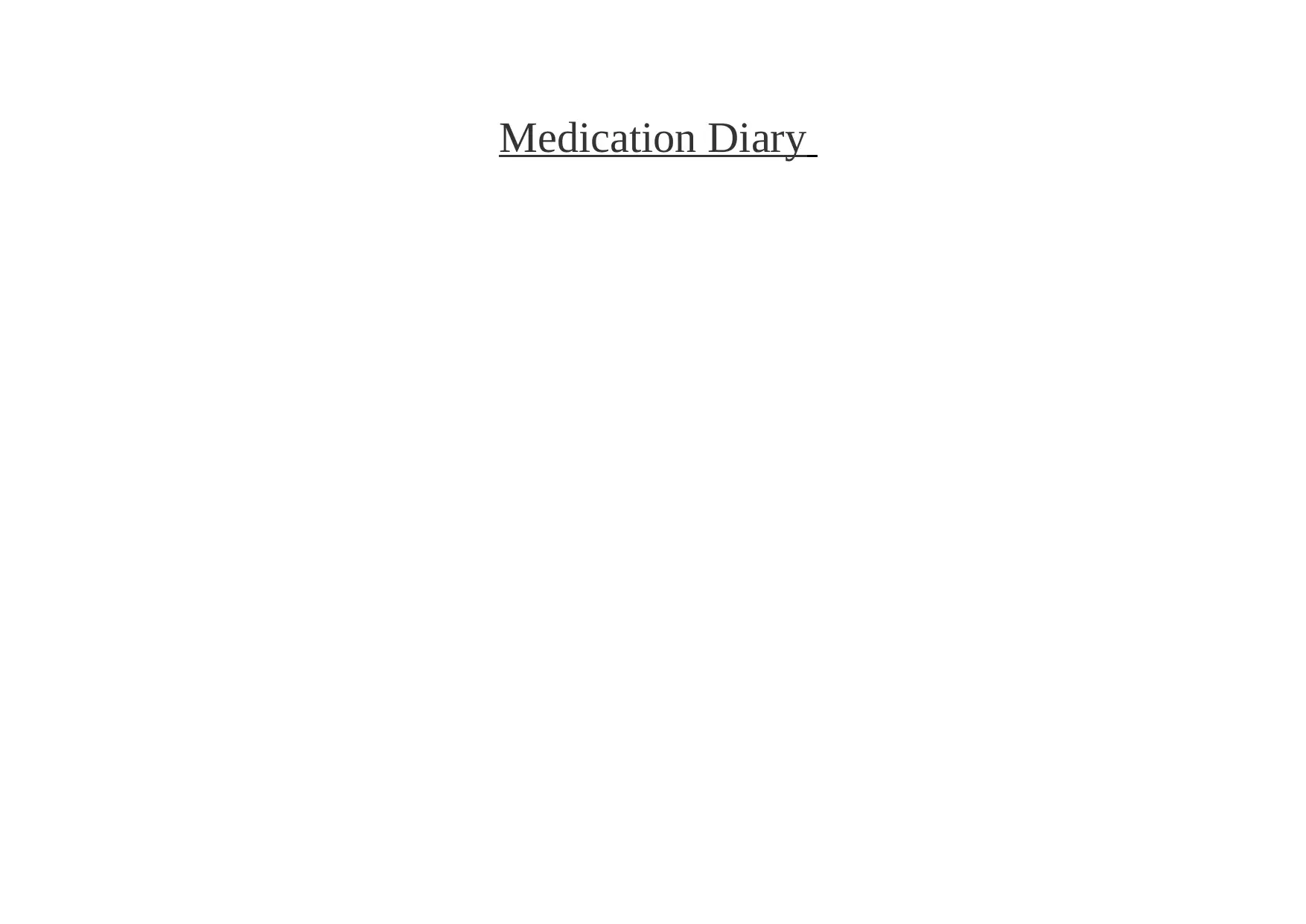
Medication Diary
Paraphrase This Document
Need a fresh take? Get an instant paraphrase of this document with our AI Paraphraser
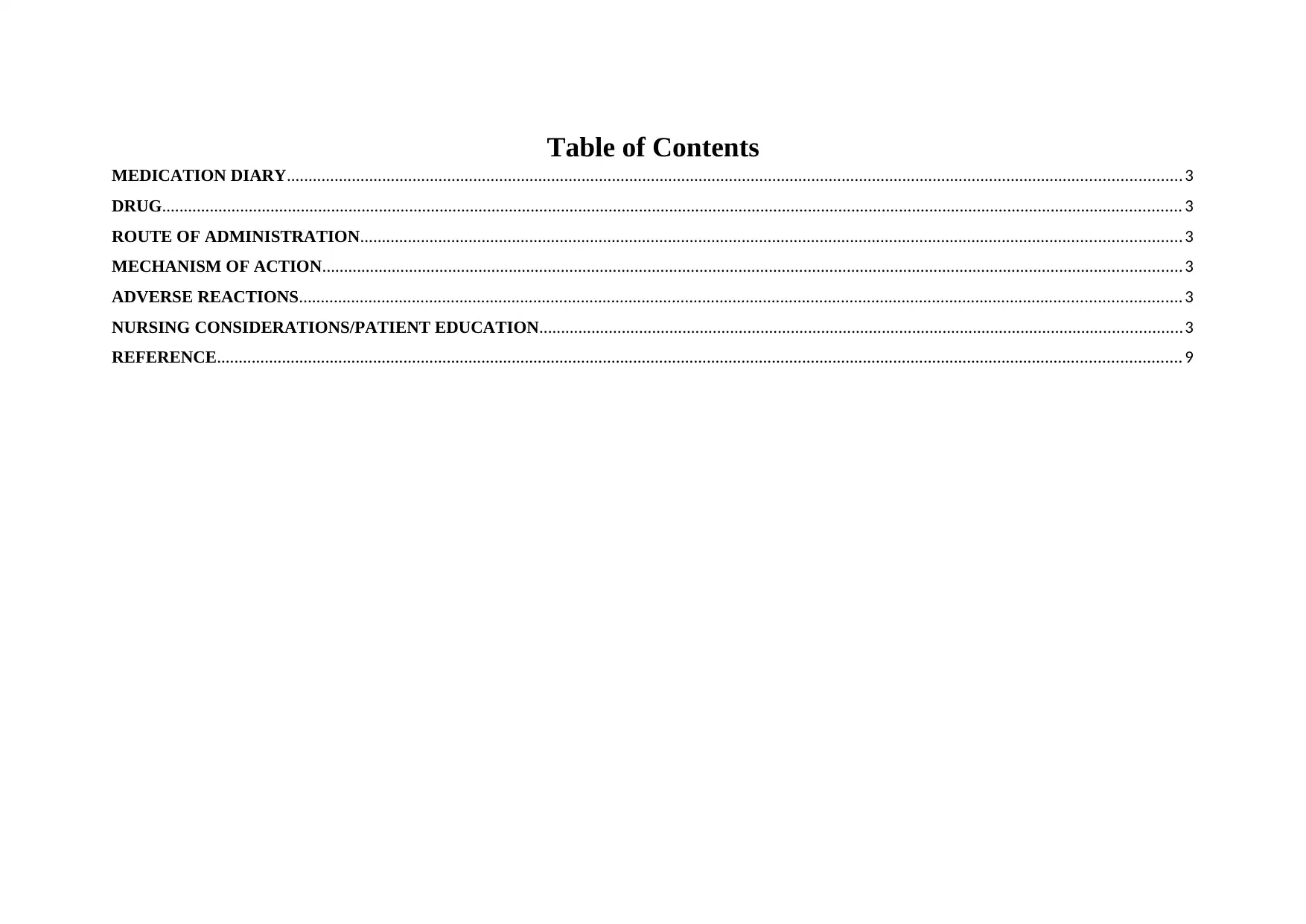
Table of Contents
MEDICATION DIARY.............................................................................................................................................................................................................. 3
DRUG........................................................................................................................................................................................................................................... 3
ROUTE OF ADMINISTRATION............................................................................................................................................................................................. 3
MECHANISM OF ACTION...................................................................................................................................................................................................... 3
ADVERSE REACTIONS........................................................................................................................................................................................................... 3
NURSING CONSIDERATIONS/PATIENT EDUCATION....................................................................................................................................................3
REFERENCE.............................................................................................................................................................................................................................. 9
MEDICATION DIARY.............................................................................................................................................................................................................. 3
DRUG........................................................................................................................................................................................................................................... 3
ROUTE OF ADMINISTRATION............................................................................................................................................................................................. 3
MECHANISM OF ACTION...................................................................................................................................................................................................... 3
ADVERSE REACTIONS........................................................................................................................................................................................................... 3
NURSING CONSIDERATIONS/PATIENT EDUCATION....................................................................................................................................................3
REFERENCE.............................................................................................................................................................................................................................. 9
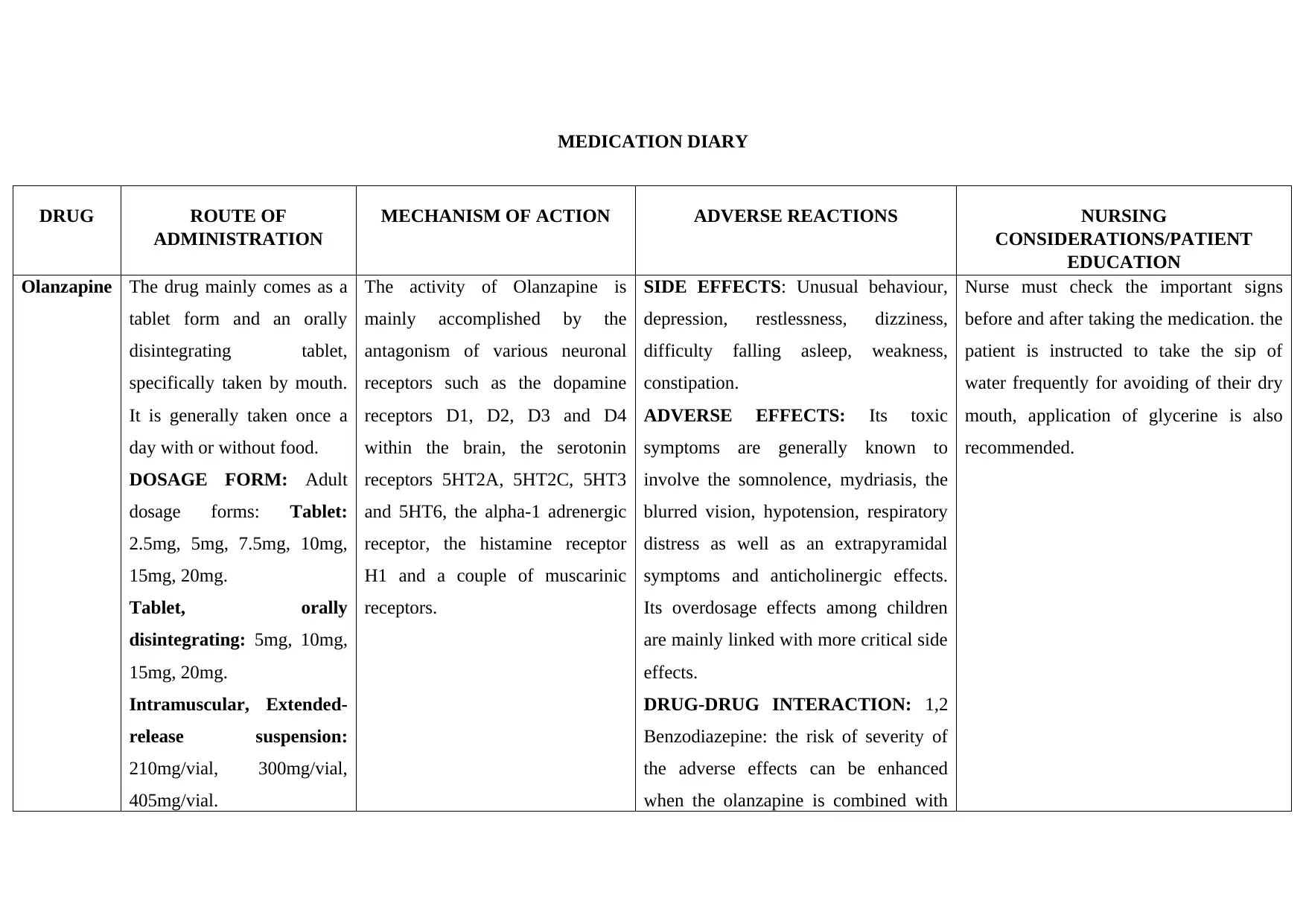
MEDICATION DIARY
DRUG ROUTE OF
ADMINISTRATION
MECHANISM OF ACTION ADVERSE REACTIONS NURSING
CONSIDERATIONS/PATIENT
EDUCATION
Olanzapine The drug mainly comes as a
tablet form and an orally
disintegrating tablet,
specifically taken by mouth.
It is generally taken once a
day with or without food.
DOSAGE FORM: Adult
dosage forms: Tablet:
2.5mg, 5mg, 7.5mg, 10mg,
15mg, 20mg.
Tablet, orally
disintegrating: 5mg, 10mg,
15mg, 20mg.
Intramuscular, Extended-
release suspension:
210mg/vial, 300mg/vial,
405mg/vial.
The activity of Olanzapine is
mainly accomplished by the
antagonism of various neuronal
receptors such as the dopamine
receptors D1, D2, D3 and D4
within the brain, the serotonin
receptors 5HT2A, 5HT2C, 5HT3
and 5HT6, the alpha-1 adrenergic
receptor, the histamine receptor
H1 and a couple of muscarinic
receptors.
SIDE EFFECTS: Unusual behaviour,
depression, restlessness, dizziness,
difficulty falling asleep, weakness,
constipation.
ADVERSE EFFECTS: Its toxic
symptoms are generally known to
involve the somnolence, mydriasis, the
blurred vision, hypotension, respiratory
distress as well as an extrapyramidal
symptoms and anticholinergic effects.
Its overdosage effects among children
are mainly linked with more critical side
effects.
DRUG-DRUG INTERACTION: 1,2
Benzodiazepine: the risk of severity of
the adverse effects can be enhanced
when the olanzapine is combined with
Nurse must check the important signs
before and after taking the medication. the
patient is instructed to take the sip of
water frequently for avoiding of their dry
mouth, application of glycerine is also
recommended.
DRUG ROUTE OF
ADMINISTRATION
MECHANISM OF ACTION ADVERSE REACTIONS NURSING
CONSIDERATIONS/PATIENT
EDUCATION
Olanzapine The drug mainly comes as a
tablet form and an orally
disintegrating tablet,
specifically taken by mouth.
It is generally taken once a
day with or without food.
DOSAGE FORM: Adult
dosage forms: Tablet:
2.5mg, 5mg, 7.5mg, 10mg,
15mg, 20mg.
Tablet, orally
disintegrating: 5mg, 10mg,
15mg, 20mg.
Intramuscular, Extended-
release suspension:
210mg/vial, 300mg/vial,
405mg/vial.
The activity of Olanzapine is
mainly accomplished by the
antagonism of various neuronal
receptors such as the dopamine
receptors D1, D2, D3 and D4
within the brain, the serotonin
receptors 5HT2A, 5HT2C, 5HT3
and 5HT6, the alpha-1 adrenergic
receptor, the histamine receptor
H1 and a couple of muscarinic
receptors.
SIDE EFFECTS: Unusual behaviour,
depression, restlessness, dizziness,
difficulty falling asleep, weakness,
constipation.
ADVERSE EFFECTS: Its toxic
symptoms are generally known to
involve the somnolence, mydriasis, the
blurred vision, hypotension, respiratory
distress as well as an extrapyramidal
symptoms and anticholinergic effects.
Its overdosage effects among children
are mainly linked with more critical side
effects.
DRUG-DRUG INTERACTION: 1,2
Benzodiazepine: the risk of severity of
the adverse effects can be enhanced
when the olanzapine is combined with
Nurse must check the important signs
before and after taking the medication. the
patient is instructed to take the sip of
water frequently for avoiding of their dry
mouth, application of glycerine is also
recommended.
⊘ This is a preview!⊘
Do you want full access?
Subscribe today to unlock all pages.

Trusted by 1+ million students worldwide
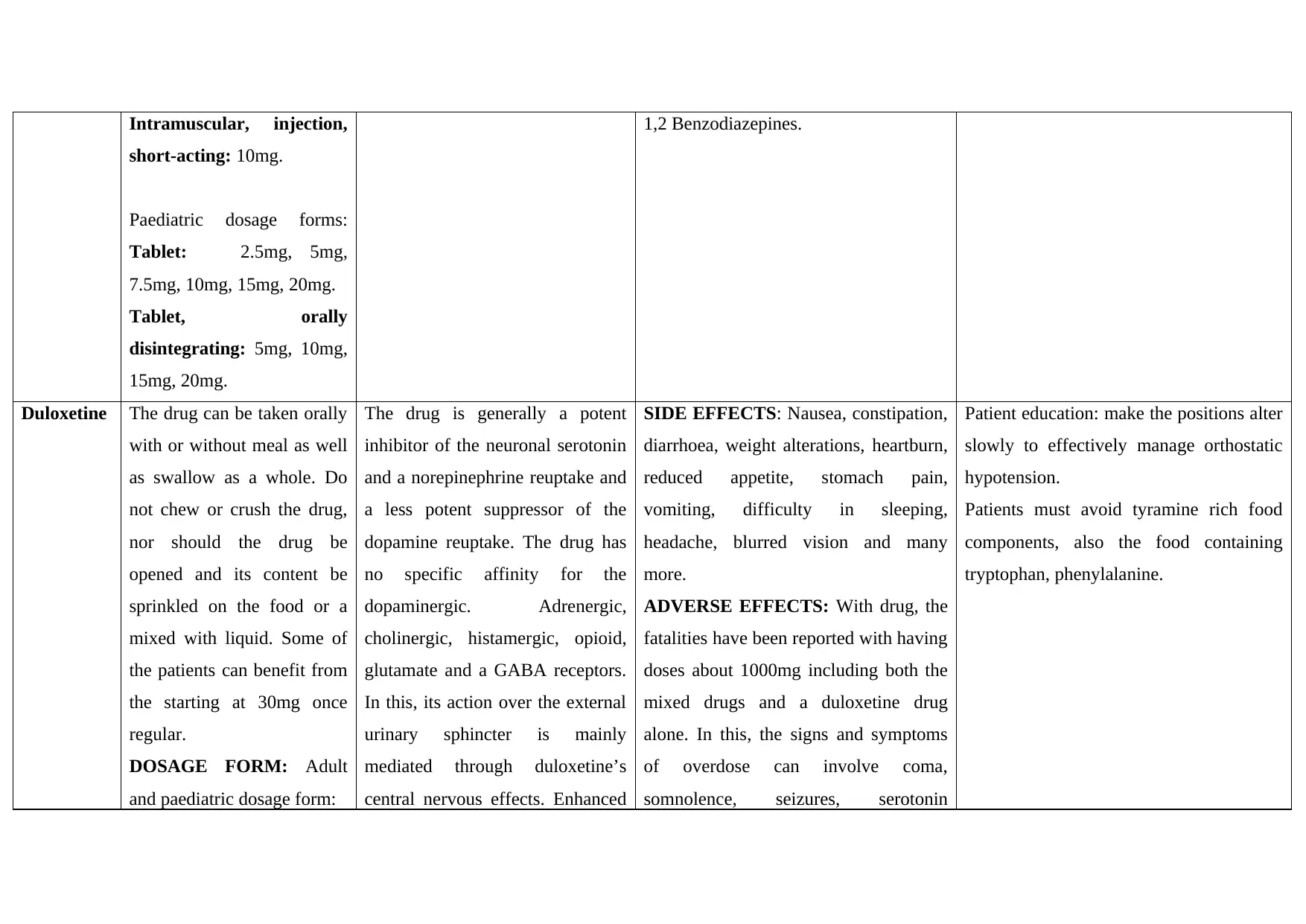
Intramuscular, injection,
short-acting: 10mg.
Paediatric dosage forms:
Tablet: 2.5mg, 5mg,
7.5mg, 10mg, 15mg, 20mg.
Tablet, orally
disintegrating: 5mg, 10mg,
15mg, 20mg.
1,2 Benzodiazepines.
Duloxetine The drug can be taken orally
with or without meal as well
as swallow as a whole. Do
not chew or crush the drug,
nor should the drug be
opened and its content be
sprinkled on the food or a
mixed with liquid. Some of
the patients can benefit from
the starting at 30mg once
regular.
DOSAGE FORM: Adult
and paediatric dosage form:
The drug is generally a potent
inhibitor of the neuronal serotonin
and a norepinephrine reuptake and
a less potent suppressor of the
dopamine reuptake. The drug has
no specific affinity for the
dopaminergic. Adrenergic,
cholinergic, histamergic, opioid,
glutamate and a GABA receptors.
In this, its action over the external
urinary sphincter is mainly
mediated through duloxetine’s
central nervous effects. Enhanced
SIDE EFFECTS: Nausea, constipation,
diarrhoea, weight alterations, heartburn,
reduced appetite, stomach pain,
vomiting, difficulty in sleeping,
headache, blurred vision and many
more.
ADVERSE EFFECTS: With drug, the
fatalities have been reported with having
doses about 1000mg including both the
mixed drugs and a duloxetine drug
alone. In this, the signs and symptoms
of overdose can involve coma,
somnolence, seizures, serotonin
Patient education: make the positions alter
slowly to effectively manage orthostatic
hypotension.
Patients must avoid tyramine rich food
components, also the food containing
tryptophan, phenylalanine.
short-acting: 10mg.
Paediatric dosage forms:
Tablet: 2.5mg, 5mg,
7.5mg, 10mg, 15mg, 20mg.
Tablet, orally
disintegrating: 5mg, 10mg,
15mg, 20mg.
1,2 Benzodiazepines.
Duloxetine The drug can be taken orally
with or without meal as well
as swallow as a whole. Do
not chew or crush the drug,
nor should the drug be
opened and its content be
sprinkled on the food or a
mixed with liquid. Some of
the patients can benefit from
the starting at 30mg once
regular.
DOSAGE FORM: Adult
and paediatric dosage form:
The drug is generally a potent
inhibitor of the neuronal serotonin
and a norepinephrine reuptake and
a less potent suppressor of the
dopamine reuptake. The drug has
no specific affinity for the
dopaminergic. Adrenergic,
cholinergic, histamergic, opioid,
glutamate and a GABA receptors.
In this, its action over the external
urinary sphincter is mainly
mediated through duloxetine’s
central nervous effects. Enhanced
SIDE EFFECTS: Nausea, constipation,
diarrhoea, weight alterations, heartburn,
reduced appetite, stomach pain,
vomiting, difficulty in sleeping,
headache, blurred vision and many
more.
ADVERSE EFFECTS: With drug, the
fatalities have been reported with having
doses about 1000mg including both the
mixed drugs and a duloxetine drug
alone. In this, the signs and symptoms
of overdose can involve coma,
somnolence, seizures, serotonin
Patient education: make the positions alter
slowly to effectively manage orthostatic
hypotension.
Patients must avoid tyramine rich food
components, also the food containing
tryptophan, phenylalanine.
Paraphrase This Document
Need a fresh take? Get an instant paraphrase of this document with our AI Paraphraser
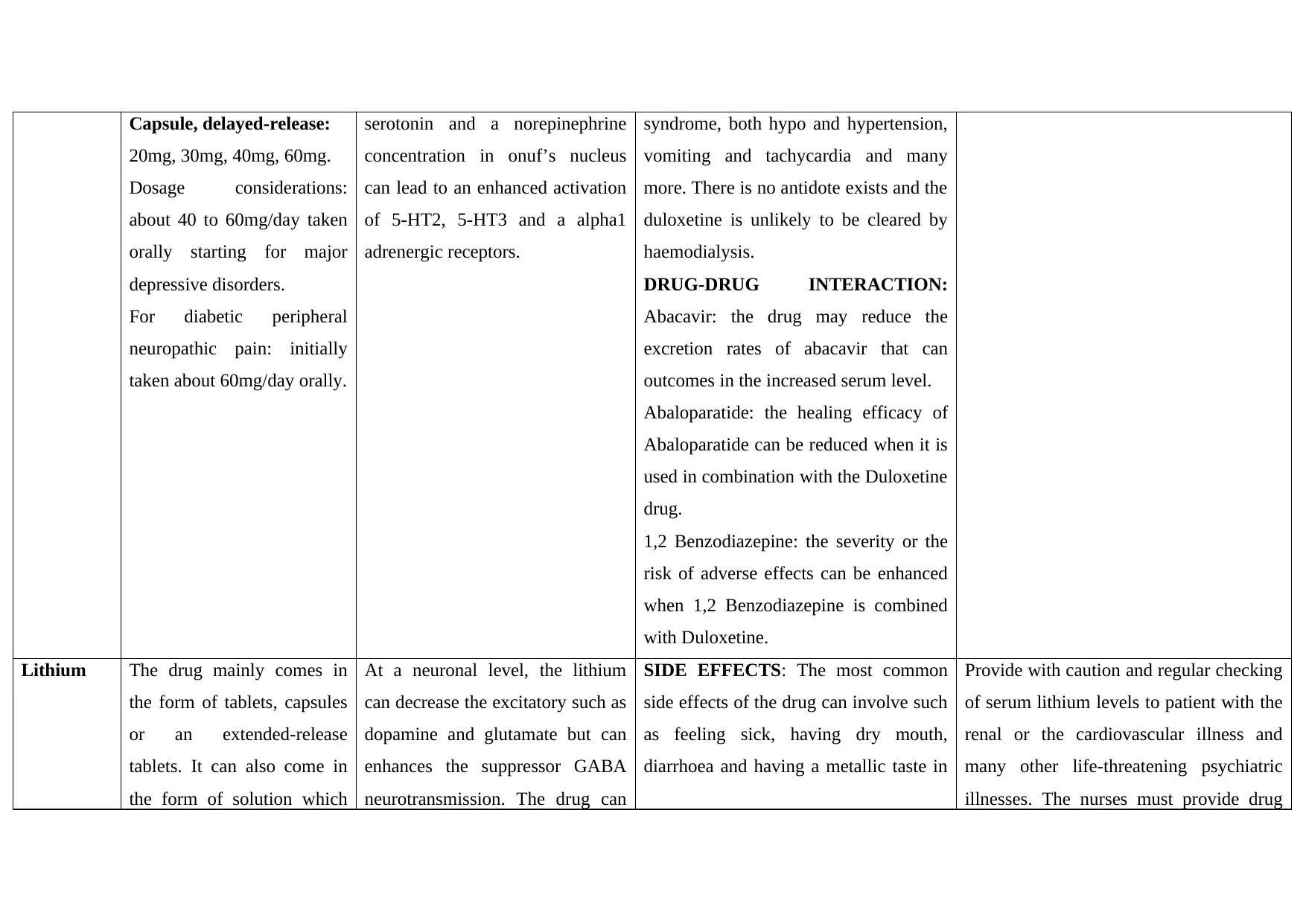
Capsule, delayed-release:
20mg, 30mg, 40mg, 60mg.
Dosage considerations:
about 40 to 60mg/day taken
orally starting for major
depressive disorders.
For diabetic peripheral
neuropathic pain: initially
taken about 60mg/day orally.
serotonin and a norepinephrine
concentration in onuf’s nucleus
can lead to an enhanced activation
of 5-HT2, 5-HT3 and a alpha1
adrenergic receptors.
syndrome, both hypo and hypertension,
vomiting and tachycardia and many
more. There is no antidote exists and the
duloxetine is unlikely to be cleared by
haemodialysis.
DRUG-DRUG INTERACTION:
Abacavir: the drug may reduce the
excretion rates of abacavir that can
outcomes in the increased serum level.
Abaloparatide: the healing efficacy of
Abaloparatide can be reduced when it is
used in combination with the Duloxetine
drug.
1,2 Benzodiazepine: the severity or the
risk of adverse effects can be enhanced
when 1,2 Benzodiazepine is combined
with Duloxetine.
Lithium The drug mainly comes in
the form of tablets, capsules
or an extended-release
tablets. It can also come in
the form of solution which
At a neuronal level, the lithium
can decrease the excitatory such as
dopamine and glutamate but can
enhances the suppressor GABA
neurotransmission. The drug can
SIDE EFFECTS: The most common
side effects of the drug can involve such
as feeling sick, having dry mouth,
diarrhoea and having a metallic taste in
Provide with caution and regular checking
of serum lithium levels to patient with the
renal or the cardiovascular illness and
many other life-threatening psychiatric
illnesses. The nurses must provide drug
20mg, 30mg, 40mg, 60mg.
Dosage considerations:
about 40 to 60mg/day taken
orally starting for major
depressive disorders.
For diabetic peripheral
neuropathic pain: initially
taken about 60mg/day orally.
serotonin and a norepinephrine
concentration in onuf’s nucleus
can lead to an enhanced activation
of 5-HT2, 5-HT3 and a alpha1
adrenergic receptors.
syndrome, both hypo and hypertension,
vomiting and tachycardia and many
more. There is no antidote exists and the
duloxetine is unlikely to be cleared by
haemodialysis.
DRUG-DRUG INTERACTION:
Abacavir: the drug may reduce the
excretion rates of abacavir that can
outcomes in the increased serum level.
Abaloparatide: the healing efficacy of
Abaloparatide can be reduced when it is
used in combination with the Duloxetine
drug.
1,2 Benzodiazepine: the severity or the
risk of adverse effects can be enhanced
when 1,2 Benzodiazepine is combined
with Duloxetine.
Lithium The drug mainly comes in
the form of tablets, capsules
or an extended-release
tablets. It can also come in
the form of solution which
At a neuronal level, the lithium
can decrease the excitatory such as
dopamine and glutamate but can
enhances the suppressor GABA
neurotransmission. The drug can
SIDE EFFECTS: The most common
side effects of the drug can involve such
as feeling sick, having dry mouth,
diarrhoea and having a metallic taste in
Provide with caution and regular checking
of serum lithium levels to patient with the
renal or the cardiovascular illness and
many other life-threatening psychiatric
illnesses. The nurses must provide drug
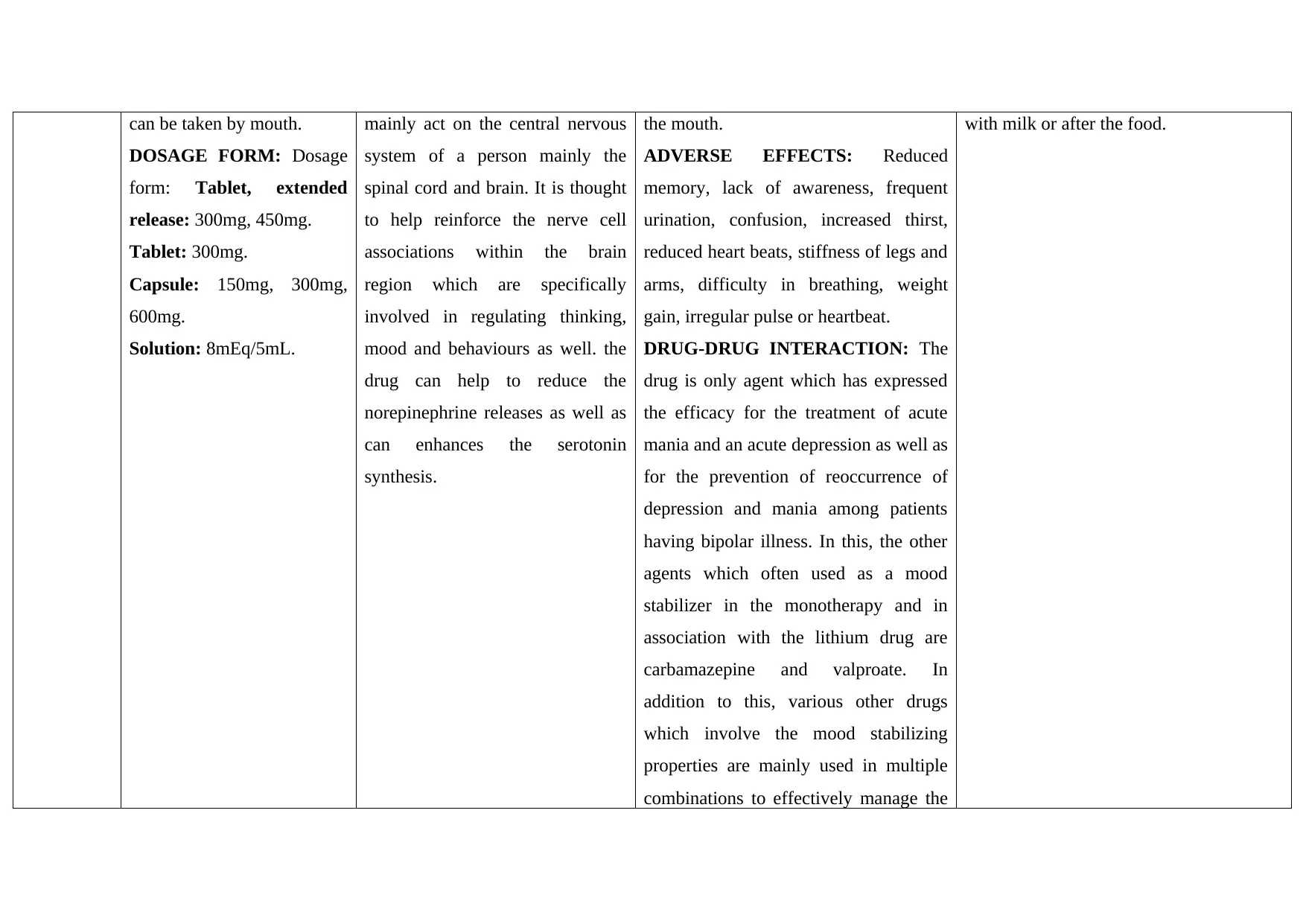
can be taken by mouth.
DOSAGE FORM: Dosage
form: Tablet, extended
release: 300mg, 450mg.
Tablet: 300mg.
Capsule: 150mg, 300mg,
600mg.
Solution: 8mEq/5mL.
mainly act on the central nervous
system of a person mainly the
spinal cord and brain. It is thought
to help reinforce the nerve cell
associations within the brain
region which are specifically
involved in regulating thinking,
mood and behaviours as well. the
drug can help to reduce the
norepinephrine releases as well as
can enhances the serotonin
synthesis.
the mouth.
ADVERSE EFFECTS: Reduced
memory, lack of awareness, frequent
urination, confusion, increased thirst,
reduced heart beats, stiffness of legs and
arms, difficulty in breathing, weight
gain, irregular pulse or heartbeat.
DRUG-DRUG INTERACTION: The
drug is only agent which has expressed
the efficacy for the treatment of acute
mania and an acute depression as well as
for the prevention of reoccurrence of
depression and mania among patients
having bipolar illness. In this, the other
agents which often used as a mood
stabilizer in the monotherapy and in
association with the lithium drug are
carbamazepine and valproate. In
addition to this, various other drugs
which involve the mood stabilizing
properties are mainly used in multiple
combinations to effectively manage the
with milk or after the food.
DOSAGE FORM: Dosage
form: Tablet, extended
release: 300mg, 450mg.
Tablet: 300mg.
Capsule: 150mg, 300mg,
600mg.
Solution: 8mEq/5mL.
mainly act on the central nervous
system of a person mainly the
spinal cord and brain. It is thought
to help reinforce the nerve cell
associations within the brain
region which are specifically
involved in regulating thinking,
mood and behaviours as well. the
drug can help to reduce the
norepinephrine releases as well as
can enhances the serotonin
synthesis.
the mouth.
ADVERSE EFFECTS: Reduced
memory, lack of awareness, frequent
urination, confusion, increased thirst,
reduced heart beats, stiffness of legs and
arms, difficulty in breathing, weight
gain, irregular pulse or heartbeat.
DRUG-DRUG INTERACTION: The
drug is only agent which has expressed
the efficacy for the treatment of acute
mania and an acute depression as well as
for the prevention of reoccurrence of
depression and mania among patients
having bipolar illness. In this, the other
agents which often used as a mood
stabilizer in the monotherapy and in
association with the lithium drug are
carbamazepine and valproate. In
addition to this, various other drugs
which involve the mood stabilizing
properties are mainly used in multiple
combinations to effectively manage the
with milk or after the food.
⊘ This is a preview!⊘
Do you want full access?
Subscribe today to unlock all pages.

Trusted by 1+ million students worldwide
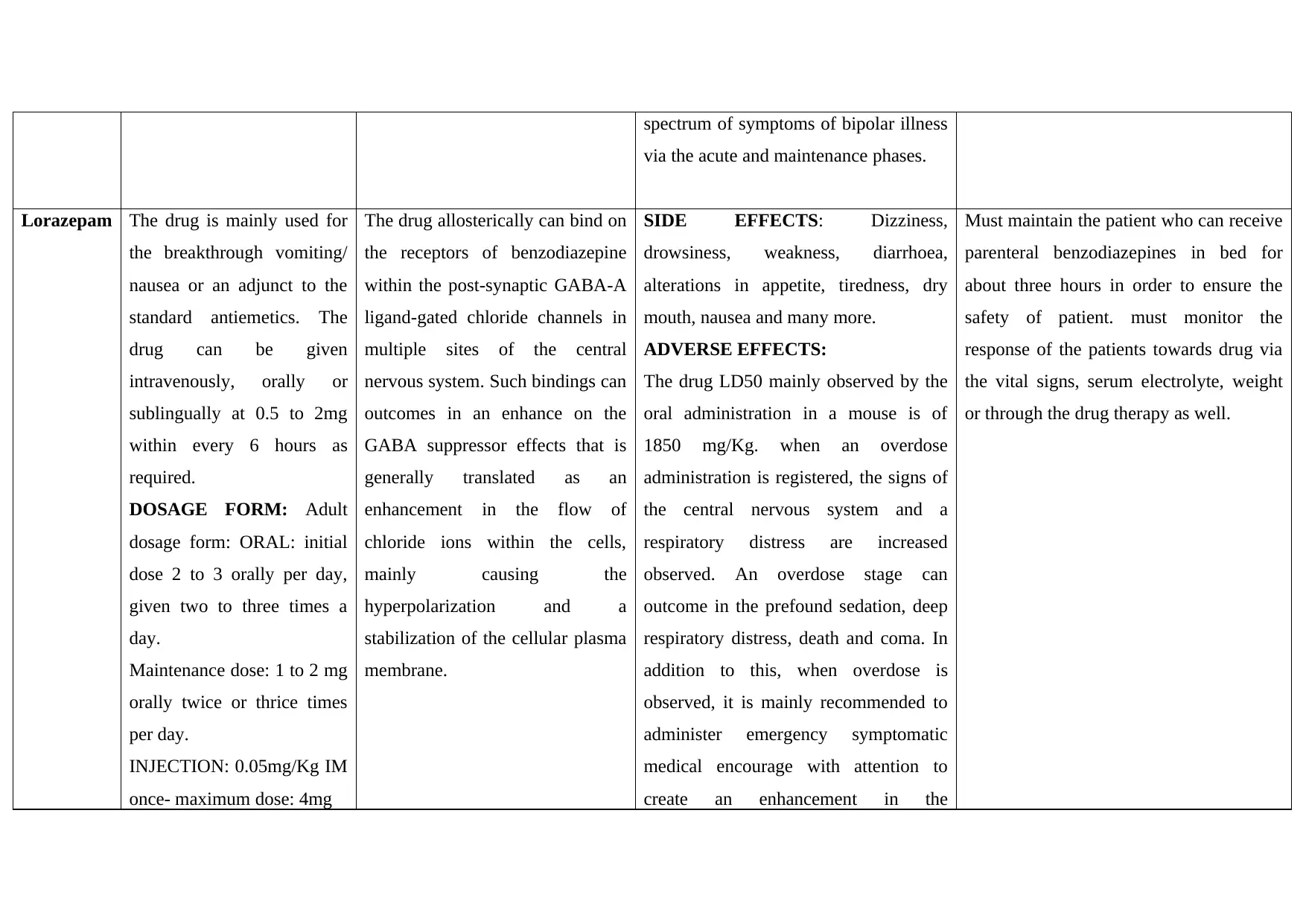
spectrum of symptoms of bipolar illness
via the acute and maintenance phases.
Lorazepam The drug is mainly used for
the breakthrough vomiting/
nausea or an adjunct to the
standard antiemetics. The
drug can be given
intravenously, orally or
sublingually at 0.5 to 2mg
within every 6 hours as
required.
DOSAGE FORM: Adult
dosage form: ORAL: initial
dose 2 to 3 orally per day,
given two to three times a
day.
Maintenance dose: 1 to 2 mg
orally twice or thrice times
per day.
INJECTION: 0.05mg/Kg IM
once- maximum dose: 4mg
The drug allosterically can bind on
the receptors of benzodiazepine
within the post-synaptic GABA-A
ligand-gated chloride channels in
multiple sites of the central
nervous system. Such bindings can
outcomes in an enhance on the
GABA suppressor effects that is
generally translated as an
enhancement in the flow of
chloride ions within the cells,
mainly causing the
hyperpolarization and a
stabilization of the cellular plasma
membrane.
SIDE EFFECTS: Dizziness,
drowsiness, weakness, diarrhoea,
alterations in appetite, tiredness, dry
mouth, nausea and many more.
ADVERSE EFFECTS:
The drug LD50 mainly observed by the
oral administration in a mouse is of
1850 mg/Kg. when an overdose
administration is registered, the signs of
the central nervous system and a
respiratory distress are increased
observed. An overdose stage can
outcome in the prefound sedation, deep
respiratory distress, death and coma. In
addition to this, when overdose is
observed, it is mainly recommended to
administer emergency symptomatic
medical encourage with attention to
create an enhancement in the
Must maintain the patient who can receive
parenteral benzodiazepines in bed for
about three hours in order to ensure the
safety of patient. must monitor the
response of the patients towards drug via
the vital signs, serum electrolyte, weight
or through the drug therapy as well.
via the acute and maintenance phases.
Lorazepam The drug is mainly used for
the breakthrough vomiting/
nausea or an adjunct to the
standard antiemetics. The
drug can be given
intravenously, orally or
sublingually at 0.5 to 2mg
within every 6 hours as
required.
DOSAGE FORM: Adult
dosage form: ORAL: initial
dose 2 to 3 orally per day,
given two to three times a
day.
Maintenance dose: 1 to 2 mg
orally twice or thrice times
per day.
INJECTION: 0.05mg/Kg IM
once- maximum dose: 4mg
The drug allosterically can bind on
the receptors of benzodiazepine
within the post-synaptic GABA-A
ligand-gated chloride channels in
multiple sites of the central
nervous system. Such bindings can
outcomes in an enhance on the
GABA suppressor effects that is
generally translated as an
enhancement in the flow of
chloride ions within the cells,
mainly causing the
hyperpolarization and a
stabilization of the cellular plasma
membrane.
SIDE EFFECTS: Dizziness,
drowsiness, weakness, diarrhoea,
alterations in appetite, tiredness, dry
mouth, nausea and many more.
ADVERSE EFFECTS:
The drug LD50 mainly observed by the
oral administration in a mouse is of
1850 mg/Kg. when an overdose
administration is registered, the signs of
the central nervous system and a
respiratory distress are increased
observed. An overdose stage can
outcome in the prefound sedation, deep
respiratory distress, death and coma. In
addition to this, when overdose is
observed, it is mainly recommended to
administer emergency symptomatic
medical encourage with attention to
create an enhancement in the
Must maintain the patient who can receive
parenteral benzodiazepines in bed for
about three hours in order to ensure the
safety of patient. must monitor the
response of the patients towards drug via
the vital signs, serum electrolyte, weight
or through the drug therapy as well.
Paraphrase This Document
Need a fresh take? Get an instant paraphrase of this document with our AI Paraphraser
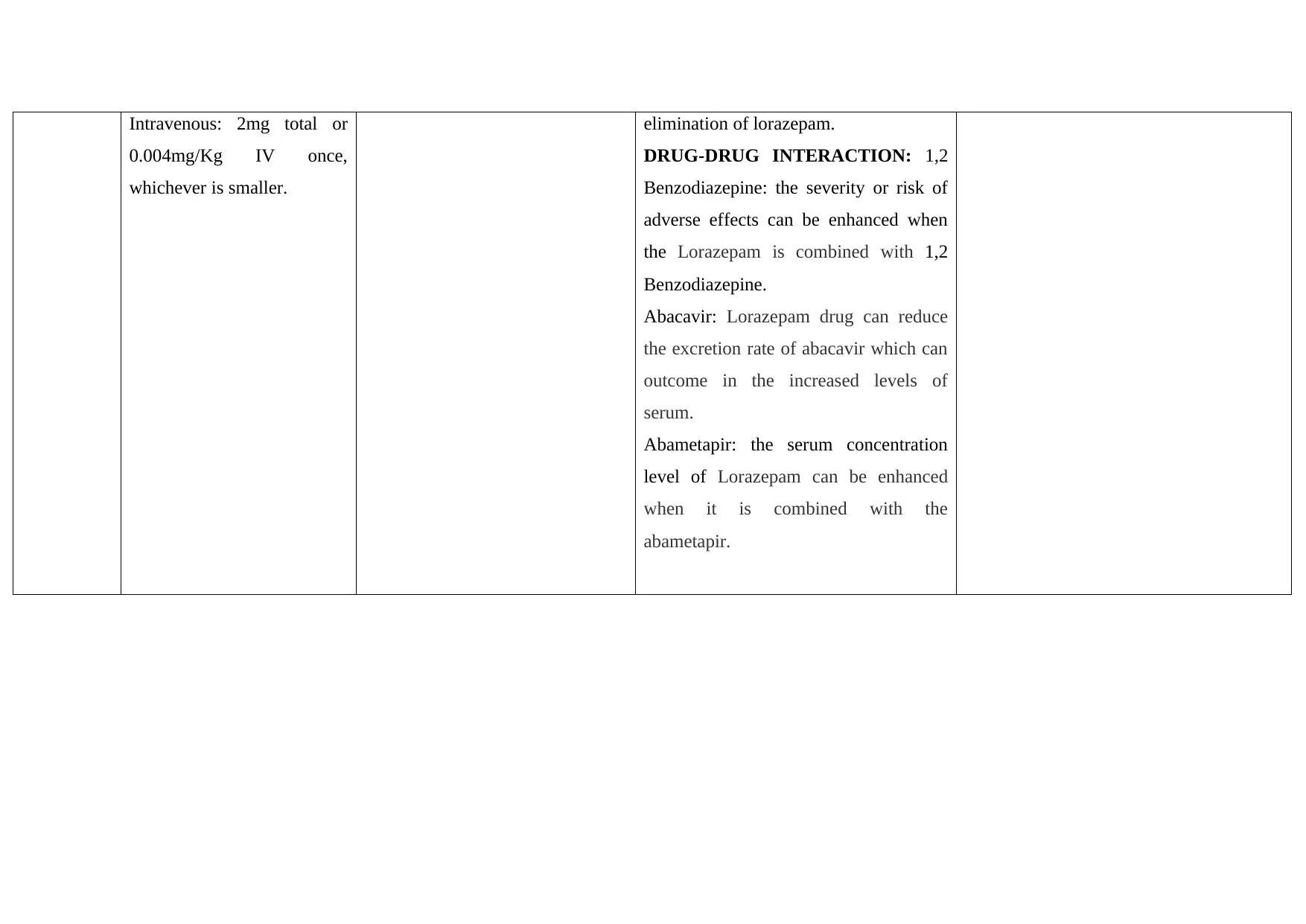
Intravenous: 2mg total or
0.004mg/Kg IV once,
whichever is smaller.
elimination of lorazepam.
DRUG-DRUG INTERACTION: 1,2
Benzodiazepine: the severity or risk of
adverse effects can be enhanced when
the Lorazepam is combined with 1,2
Benzodiazepine.
Abacavir: Lorazepam drug can reduce
the excretion rate of abacavir which can
outcome in the increased levels of
serum.
Abametapir: the serum concentration
level of Lorazepam can be enhanced
when it is combined with the
abametapir.
0.004mg/Kg IV once,
whichever is smaller.
elimination of lorazepam.
DRUG-DRUG INTERACTION: 1,2
Benzodiazepine: the severity or risk of
adverse effects can be enhanced when
the Lorazepam is combined with 1,2
Benzodiazepine.
Abacavir: Lorazepam drug can reduce
the excretion rate of abacavir which can
outcome in the increased levels of
serum.
Abametapir: the serum concentration
level of Lorazepam can be enhanced
when it is combined with the
abametapir.
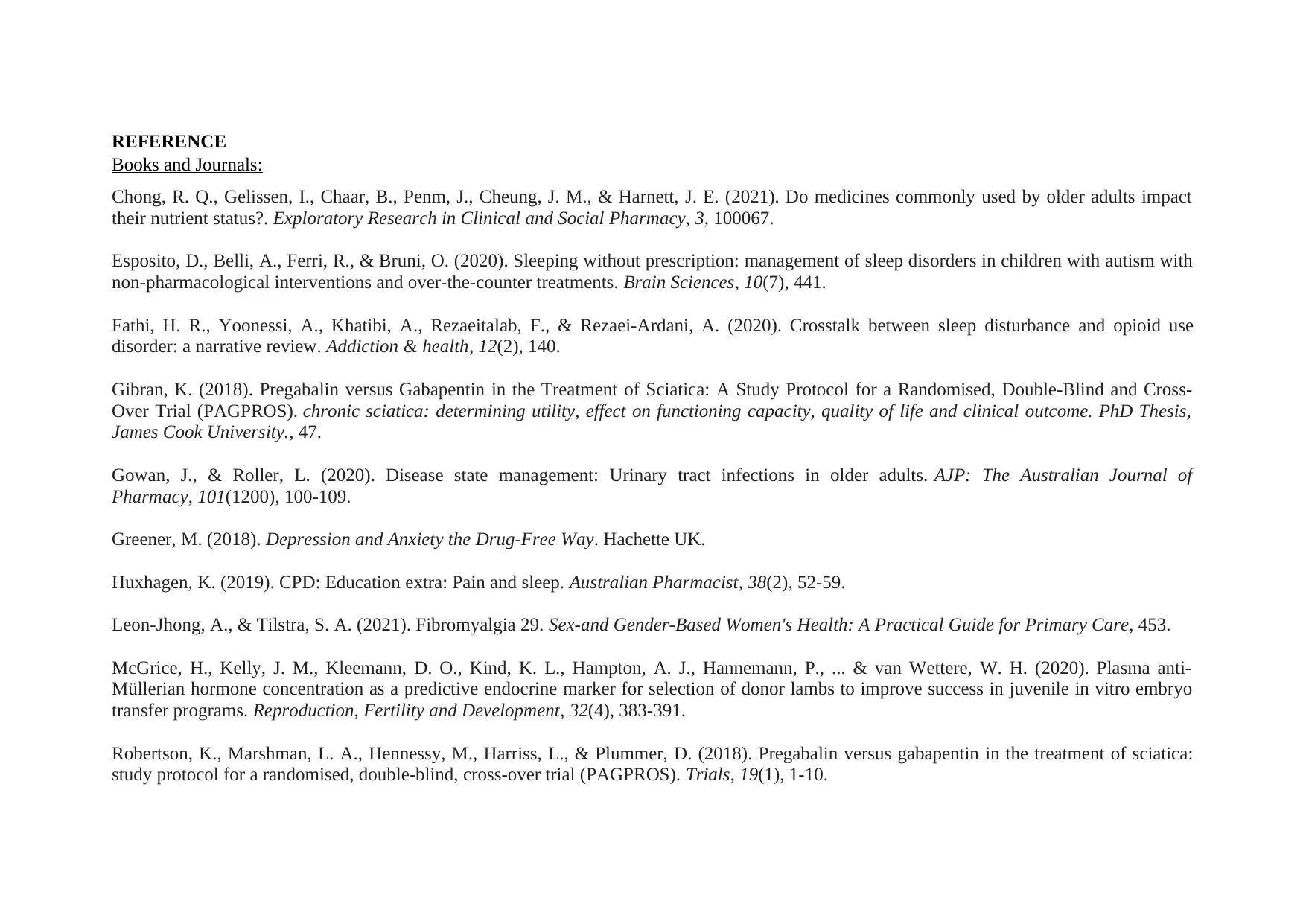
REFERENCE
Books and Journals:
Chong, R. Q., Gelissen, I., Chaar, B., Penm, J., Cheung, J. M., & Harnett, J. E. (2021). Do medicines commonly used by older adults impact
their nutrient status?. Exploratory Research in Clinical and Social Pharmacy, 3, 100067.
Esposito, D., Belli, A., Ferri, R., & Bruni, O. (2020). Sleeping without prescription: management of sleep disorders in children with autism with
non-pharmacological interventions and over-the-counter treatments. Brain Sciences, 10(7), 441.
Fathi, H. R., Yoonessi, A., Khatibi, A., Rezaeitalab, F., & Rezaei-Ardani, A. (2020). Crosstalk between sleep disturbance and opioid use
disorder: a narrative review. Addiction & health, 12(2), 140.
Gibran, K. (2018). Pregabalin versus Gabapentin in the Treatment of Sciatica: A Study Protocol for a Randomised, Double-Blind and Cross-
Over Trial (PAGPROS). chronic sciatica: determining utility, effect on functioning capacity, quality of life and clinical outcome. PhD Thesis,
James Cook University., 47.
Gowan, J., & Roller, L. (2020). Disease state management: Urinary tract infections in older adults. AJP: The Australian Journal of
Pharmacy, 101(1200), 100-109.
Greener, M. (2018). Depression and Anxiety the Drug-Free Way. Hachette UK.
Huxhagen, K. (2019). CPD: Education extra: Pain and sleep. Australian Pharmacist, 38(2), 52-59.
Leon-Jhong, A., & Tilstra, S. A. (2021). Fibromyalgia 29. Sex-and Gender-Based Women's Health: A Practical Guide for Primary Care, 453.
McGrice, H., Kelly, J. M., Kleemann, D. O., Kind, K. L., Hampton, A. J., Hannemann, P., ... & van Wettere, W. H. (2020). Plasma anti-
Müllerian hormone concentration as a predictive endocrine marker for selection of donor lambs to improve success in juvenile in vitro embryo
transfer programs. Reproduction, Fertility and Development, 32(4), 383-391.
Robertson, K., Marshman, L. A., Hennessy, M., Harriss, L., & Plummer, D. (2018). Pregabalin versus gabapentin in the treatment of sciatica:
study protocol for a randomised, double-blind, cross-over trial (PAGPROS). Trials, 19(1), 1-10.
Books and Journals:
Chong, R. Q., Gelissen, I., Chaar, B., Penm, J., Cheung, J. M., & Harnett, J. E. (2021). Do medicines commonly used by older adults impact
their nutrient status?. Exploratory Research in Clinical and Social Pharmacy, 3, 100067.
Esposito, D., Belli, A., Ferri, R., & Bruni, O. (2020). Sleeping without prescription: management of sleep disorders in children with autism with
non-pharmacological interventions and over-the-counter treatments. Brain Sciences, 10(7), 441.
Fathi, H. R., Yoonessi, A., Khatibi, A., Rezaeitalab, F., & Rezaei-Ardani, A. (2020). Crosstalk between sleep disturbance and opioid use
disorder: a narrative review. Addiction & health, 12(2), 140.
Gibran, K. (2018). Pregabalin versus Gabapentin in the Treatment of Sciatica: A Study Protocol for a Randomised, Double-Blind and Cross-
Over Trial (PAGPROS). chronic sciatica: determining utility, effect on functioning capacity, quality of life and clinical outcome. PhD Thesis,
James Cook University., 47.
Gowan, J., & Roller, L. (2020). Disease state management: Urinary tract infections in older adults. AJP: The Australian Journal of
Pharmacy, 101(1200), 100-109.
Greener, M. (2018). Depression and Anxiety the Drug-Free Way. Hachette UK.
Huxhagen, K. (2019). CPD: Education extra: Pain and sleep. Australian Pharmacist, 38(2), 52-59.
Leon-Jhong, A., & Tilstra, S. A. (2021). Fibromyalgia 29. Sex-and Gender-Based Women's Health: A Practical Guide for Primary Care, 453.
McGrice, H., Kelly, J. M., Kleemann, D. O., Kind, K. L., Hampton, A. J., Hannemann, P., ... & van Wettere, W. H. (2020). Plasma anti-
Müllerian hormone concentration as a predictive endocrine marker for selection of donor lambs to improve success in juvenile in vitro embryo
transfer programs. Reproduction, Fertility and Development, 32(4), 383-391.
Robertson, K., Marshman, L. A., Hennessy, M., Harriss, L., & Plummer, D. (2018). Pregabalin versus gabapentin in the treatment of sciatica:
study protocol for a randomised, double-blind, cross-over trial (PAGPROS). Trials, 19(1), 1-10.
⊘ This is a preview!⊘
Do you want full access?
Subscribe today to unlock all pages.

Trusted by 1+ million students worldwide
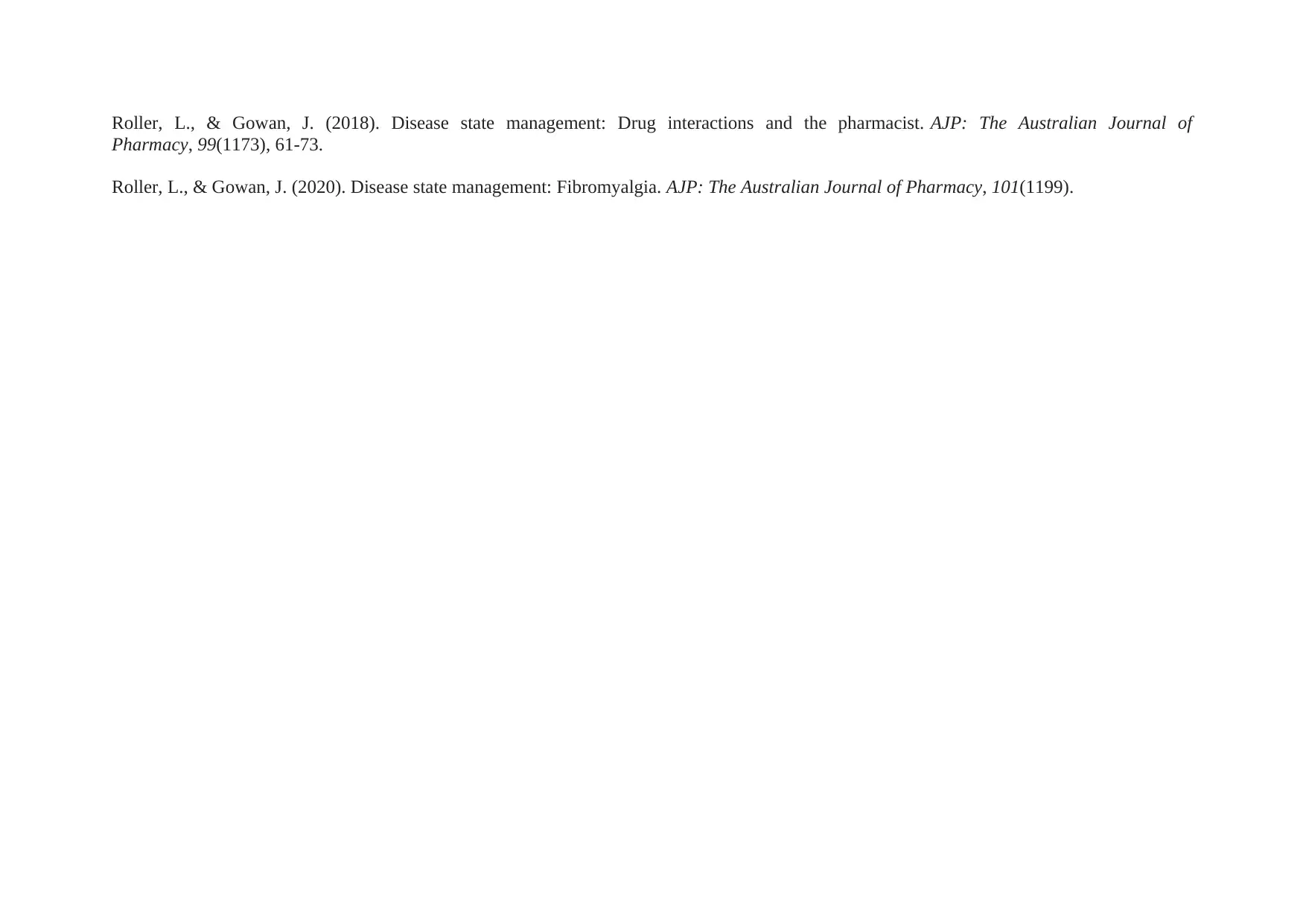
Roller, L., & Gowan, J. (2018). Disease state management: Drug interactions and the pharmacist. AJP: The Australian Journal of
Pharmacy, 99(1173), 61-73.
Roller, L., & Gowan, J. (2020). Disease state management: Fibromyalgia. AJP: The Australian Journal of Pharmacy, 101(1199).
Pharmacy, 99(1173), 61-73.
Roller, L., & Gowan, J. (2020). Disease state management: Fibromyalgia. AJP: The Australian Journal of Pharmacy, 101(1199).
1 out of 10
Your All-in-One AI-Powered Toolkit for Academic Success.
+13062052269
info@desklib.com
Available 24*7 on WhatsApp / Email
![[object Object]](/_next/static/media/star-bottom.7253800d.svg)
Unlock your academic potential
Copyright © 2020–2025 A2Z Services. All Rights Reserved. Developed and managed by ZUCOL.